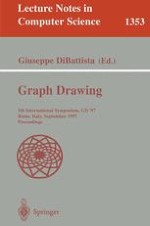1997 | ReviewPaper | Buchkapitel
Which aesthetic has the greatest effect on human understanding?
verfasst von : Helen Purchase
Erschienen in: Graph Drawing
Verlag: Springer Berlin Heidelberg
Enthalten in: Professional Book Archive
Aktivieren Sie unsere intelligente Suche, um passende Fachinhalte oder Patente zu finden.
Wählen Sie Textabschnitte aus um mit Künstlicher Intelligenz passenden Patente zu finden. powered by
Markieren Sie Textabschnitte, um KI-gestützt weitere passende Inhalte zu finden. powered by
In the creation of graph drawing algorithms and systems, designers claim that by producing layouts that optimise certain aesthetic qualities, the graphs are easier to understand. Such aesthetics include maximise symmetry, minimise edge crosses and minimise bends.A previous study aimed to validate these claims with respect to three aesthetics, using paper-based experiments [11]. The study reported here is superior in many ways: five aesthetics are considered, attempts are made to place a priority order on the relative importance of the aesthetics, the experiments are run on-line, and the ease of understanding the drawings is measured in time, as well as in the number of errors. In addition, greater consideration is given to the possible effect of confounding factors in the graph drawings.The results indicate that reducing the number of edge crosses is by far the most important aesthetic, while minimising the number of bends and maximising symmetry have a lesser effect. The effects of maximising the minimum angle between edges leaving a node and of fixing edges and nodes to an orthogonal grid are not statistically significant.This work is important since it helps to demonstrate to algorithm and system designers the aesthetic qualities most important for aiding human understanding, the most appropriate compromises to make when there is a conflict in aesthetics, and consequently, how to build more effective systems.
